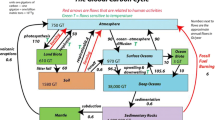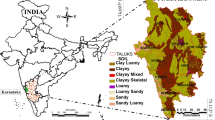Abstract
India ranks fourth in terms of greenhouse gas (GHG) emissions and accounts for 6% of total GHG emissions in the world. Carbon dioxide \((\hbox {CO}_{2})\) has major contribution of 76% in total GHG emissions. Agroforestry that integrates trees in the agricultural landscape is regarded as a strategy for both adaptation and mitigation of climate change. Agroforestry plays an important role in reducing the level of GHG emissions vis-à-vis atmospheric \(\hbox {CO}_{2}\) through carbon sequestration. Carbon sequestration is the process involved in carbon capture and the long period storage of atmospheric \(\hbox {CO}_{2}\). In the present study, firstly area under agroforestry was estimated in Central Plateau and Hill region (agro-climatic zone-8) using satellite remote sensing data. Secondly, dynamic \(\hbox {CO}_{2}\hbox {FIX}\) model v3.1 was used to assess the baseline total carbon and carbon sequestration potential (CSP) of agroforestry systems for a simulation period of 30 yr. Finally, equivalent \(\hbox {CO}_{2}\) absorption was assessed with the help of estimated agroforestry area and net CSP in the zone. Estimated area in Central Plateau and Hill region is about 1.96 million ha, which is 5.18% of total geographical area of this zone. Total carbon sequestered at zone level was estimated to be 17.81 Tg (tera gram) C and equivalent \(\hbox {CO}_{2}\) absorption is at 65.36 Tg. The CSP of agroforestry systems would be about 158.55 Tg C for a simulated period of 30 yr or CSP would be 5.28 Tg C \(\hbox {yr}^{-1}\) at country level. On the other hand, equivalent \(\hbox {CO}_{2}\) absorption was 586.50 Tg for a period of 30 yr or would be 19.55 Tg \(\hbox {yr}^{-1}\) at country level. Hence, the present study concludes that agroforestry has significant contribution in reduction of atmospheric \(\hbox {CO}_{2}\) which would have much more if the area under agroforestry and/or number of trees \(\hbox {ha}^{-1}\) on farmlands are increased.




Similar content being viewed by others
References
Ajit, Dhyani S K, Newaj R, Handa A K, Prasad R, Alam B, Rizvi R H, Gupta G, Pandey K K, Jain A and Uma 2013 Modeling analysis of potential carbon sequestration under existing agroforestry systems in three districts of Indo-Gangetic plains in India; Agroforest Syst. 87 1129–1146.
Albrecht A and Kandji S T 2003 Carbon sequestration in tropical agroforestry systems; Agric. Ecosyst. Environ. 99 15–27.
Bordon T A, Marland G and Andred R J 2015 National \(\text{CO}_{2}\) emissions from fossil fuel burning, cement manufacture and gas flaring: 1751–2011; Carbon Dioxide Information Analysis Centre, Oak Ridge National Laboratory, U.S. Department of Energy.
Dhyani S K, Newaj R and Sharma A R 2009 Agroforestry, its relation with agronomy, challenges and opportunities; Indian J. Agron. 54 249–266.
Gibbs H K, Brown S, Niles J O and Foley J A 2007 Monitoring and estimating tropical forest carbon stocks: Making REDD a reality; Envir. Res. Lett. 2 1–13.
Houghton R A, Hall F and Goetz S J 2009 Importance of biomass of the global carbon cycle; J. Geogr. Res. 114 G00–E03.
IPCC 2003 IPCC good practices guidance for land use, land use change and forestry, Chapter 3, Section 3.3.1, p. 3.70.
IPCC 2004 Good practice guidance for land use, land-use and forestry; IPCC (Intergovernmental Panel on Climate Change), Geneva, Switzerland.
IPCC AR5 2014 Climate change 2014 synthesis report: A report of the Intergovernmental Panel on Climate Change; IPCC, Geneva, Switzerland, pp. 1–151.
Kaul M, Mohren G M J and Dadhwal V K 2010 Carbon storage and sequestration potential of selected tree species in India; Mitig. Adapt. Strat. Glob. Change 15 489–510.
Lal R 2004 Soil carbon sequestration impacts on global climate change and food security; Science 304 1623–1627.
Lal R and Singh M 2000 Carbon sequestration potential of Indian forests; Environ. Monit. Assess. 60 315–327.
Luderer G, Bosetti V, Jakob Leimbach M, Steckel J C, Waisman H and Edenhofer O 2011 The economics of decarbonizing the energy system: Results and insights from the RECIPE model inter-comparison; Clim. Change 114 9–37.
Masera O, Garza-Caligaris J F, Kanninen M, Karjalainen T, Liski J, Nabuurs G J, Pussinen A and De Jong B J 2003 Modelling carbon sequestration in afforestation, agroforestry and forest management projects: The \(\text{ CO }_{2}\text{ FIX }\) V.2 approach; Ecol. Model. 164 177–199.
Montagnini F and Nair P K R 2004 Carbon sequestration: An underexploited environmental benefit of agroforestry systems; Agroforest Syst. 61 281–295.
Nair P K R 2012 Carbon sequestration studies in agroforestry systems: A reality check; Agroforest Syst. 86 243–253.
Pacala S and Socolow R 2004 Stabilization wedges – solving the climate problem for the next 50 years with current technologies; Science 305 968–972.
Pan Y et al. 2011 A large and persistent carbon sink in the world’s forests; Science 333 988–993.
Planning Commission 2001 Report on the task force on greening India for livelihood security and sustainable development; Planning Commission, Govt. of India, 254p.
Ramchandran A, Jaykumar S, Haroon R M, Bhaskaran A and Arockiasamy D I 2007 Carbon sequestration: Estimation of carbon stocks in natural forest using geospatial technology in eastern ghats of Tamil Nadu, India; Curr. Sci. 92 323–331.
Riahi K et al. 2015 Locked into Copenhagen pledges – Implications of short-term emission targets for the cost and feasibility of long-term climate goals; Technol. Forecast. Soc. Change 90 8–23.
Rizvi R H, Dhyani S K, Yadav R H and Singh Ramesh 2011 Biomass production and carbon stock of Poplar agroforestry systems in Yamunanagar and Saharanpur districts of north-western India; Curr. Sci. 100 736–742.
Rizvi R H, Dhyani S K, Newaj R, Karmakar P S and Saxena A 2014 Mapping agroforestry area in India through remote sensing and preliminary estimates; Indian Farming 63 62–64.
Rizvi R H, Newaj Ram, Prasad R, Handa A K, Alam B, Chavan S B, Saxena A, Karmakar P S, Jain A and Chaturvedi M 2016a Assessment of carbon storage potential and area under agroforestry systems in Gujarat Plains by \(\text{ CO }_{2}\text{ FIX }\) model and remote sensing techniques; Curr. Sci. 110 2005–2011.
Rizvi R H, Newaj R, Karmakar P S, Saxena A and Dhyani S K 2016b Remote sensing analysis of agroforestry in Bathinda and Patiala districts of Punjab using sub-pixel method and medium resolution data; J. Indian Soc. Rem. Sens. 44 657–664.
Rogelj J, Hare W, Lowe J, van Vuuren D P, Riahi K, Matthews B, Hanaoka T, Jiang K and Meinshausen M 2011 Emission pathways consistent with a \(2^\circ \text{ C }\) global temperature limit; Nat. Clim. Change 1 413–418.
Rogelj J, McCollum D L, O’Neill B C and Riahi K 2013 2020 emissions levels required to limit warming to below \(2^\circ \text{ C }\); Nat. Clim. Change 3 405–412.
Sanchez P A 1995 Science in agroforestry; Agroforestry Syst. 30 5–55.
Sathaye J A and Ravindranath N H 1998 Climate change mitigation in the energy and the forestry sectors of developing countries; Ann. Rev. Ener. Envir. 23 387–437.
Schelhaas M J, Van Esch P W, Groen T A, Kanninen M, Liski J, Masera O, Mohren G M J, Nabuurs G J, Pedroni L, Pussinen A, Vallejo A, Palosuo T and Vilén T 2004 \(\text{ CO }_{2}\text{ FIX }\) V 3.1 – A modelling framework for quantifying carbon sequestration in forest ecosystems; ALTERRA Report 1068 Wageningen, The Netherlands.
Schoeneberger M M 2009 Agroforestry: Working trees for sequestering carbon on agricultural lands; Agroforest. Syst. 75 27–37.
Sharma S K, Choudhury A, Sarkar P, Biswas S and Singh A et al. 2011 Greenhouse gas inventory estimates for India; Curr. Sci. 101 405–415.
Singh K and Chand P 2012 Aboveground tree outside forest (TOF) phytomass and carbon estimation in the semi-arid region of southern Haryana: A synthesis approach of remote sensing and field data; J. Earth Syst. Sci. 121 1469–1482.
Sivrikaya F, Keles S and Cakir G 2007 Spatial distribution and temporal change of carbon storage in timber biomass of two different forest management units; Environ. Monit. Assess. 132 429–438.
Swamy S L and Puri S 2005 Biomass production and C-sequestration of Gmelina arborea in plantation and agroforestry system in India; Agroforest. Syst. 64 181–195.
Turnet D P, Guzy M, Lefsky M A, Ritts W D, Tuyl S V and Law B E 2004 Monitoring forest carbon sequestration with remote sensing and carbon cycle modeling; Environ. Manag. 33 457–466.
Upgupta S, Singh S and Tiwari P S 2015 Estimation of phytomass of plantations using digital photogrammetry and high resolution remote sensing data; J. Indian Soc. Remote Sens. 43 311–323.
Watson R T, Noble I R, Bolin B, Ravindranath N H, Verarado D J and Dokken D J (eds) 2000 Land use, land use changes and forestry: A special report of the Intergovernmental Panel on Climate Change; Cambridge University Press, Cambridge, p. 375.
Zomer R J, Neufeldt H, Xu J, Ahrends A, Bossio D, Trabucco A, van Noordwijk M and Wang M 2016 Global Tree Cover and Biomass Carbon on Agricultural Land: The contribution of agroforestry to global and national carbon budgets; Sci. Rep. 6 29987; https://doi.org/10.1038/srep29987.
Acknowledgements
The authors are thankful to ICAR for funding the National Initiative on Climate Resilient Agriculture (NICRA) project and the authors are also thankful to the Director, CAFRI, Jhansi for providing support for this project.
Author information
Authors and Affiliations
Corresponding author
Additional information
Corresponding editor: Suresh Babu
Rights and permissions
About this article
Cite this article
Rizvi, R.H., Newaj, R., Chaturvedi, O.P. et al. Carbon sequestration and \(\hbox {CO}_{2}\) absorption by agroforestry systems: An assessment for Central Plateau and Hill region of India. J Earth Syst Sci 128, 56 (2019). https://doi.org/10.1007/s12040-019-1071-3
Received:
Revised:
Accepted:
Published:
DOI: https://doi.org/10.1007/s12040-019-1071-3




